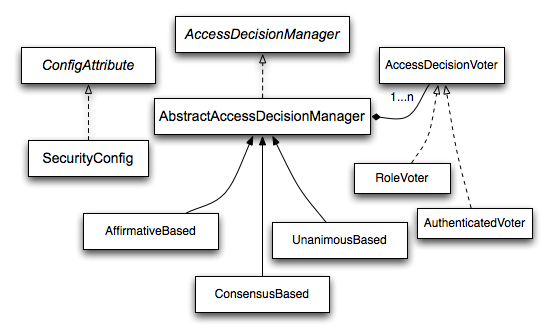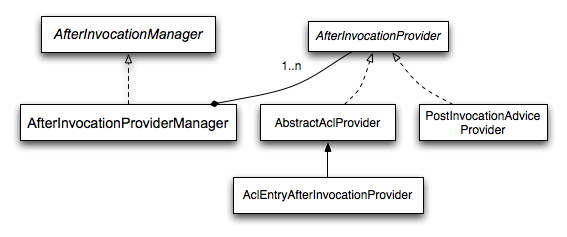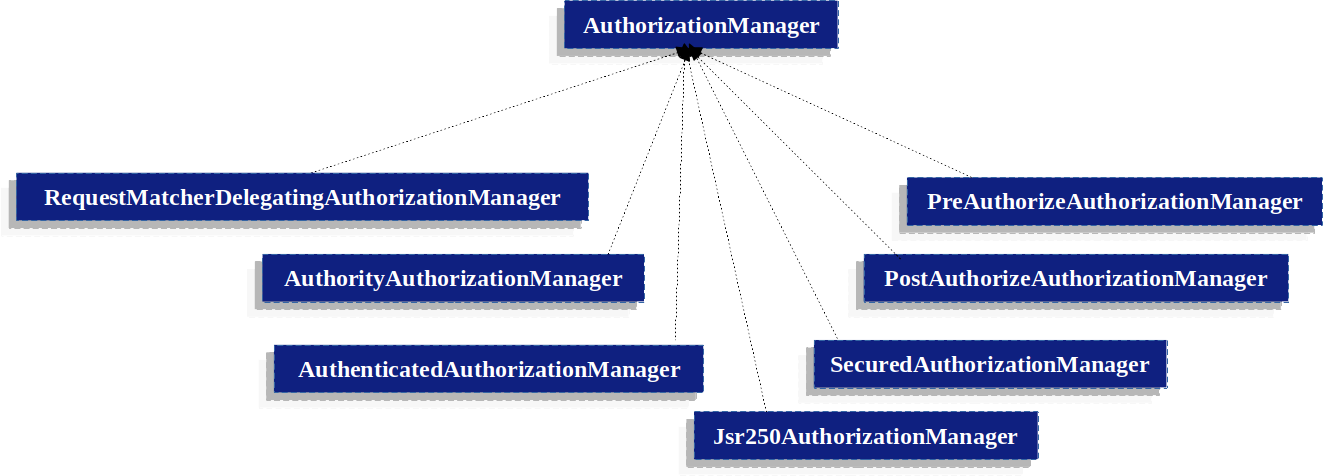|
This version is still in development and is not considered stable yet. For the latest stable version, please use Spring Security 6.3.4! |
Authorization Architecture
This section describes the Spring Security architecture that applies to authorization.
Authorities
Authentication discusses how all Authentication implementations store a list of GrantedAuthority objects.
These represent the authorities that have been granted to the principal.
The GrantedAuthority objects are inserted into the Authentication object by the AuthenticationManager and are later read by AccessDecisionManager instances when making authorization decisions.
The GrantedAuthority interface has only one method:
String getAuthority();This method is used by an
AuthorizationManager instance to obtain a precise String representation of the GrantedAuthority.
By returning a representation as a String, a GrantedAuthority can be easily "read" by most AuthorizationManager implementations.
If a GrantedAuthority cannot be precisely represented as a String, the GrantedAuthority is considered "complex" and getAuthority() must return null.
An example of a complex GrantedAuthority would be an implementation that stores a list of operations and authority thresholds that apply to different customer account numbers.
Representing this complex GrantedAuthority as a String would be quite difficult. As a result, the getAuthority() method should return null.
This indicates to any AuthorizationManager that it needs to support the specific GrantedAuthority implementation to understand its contents.
Spring Security includes one concrete GrantedAuthority implementation: SimpleGrantedAuthority.
This implementation lets any user-specified String be converted into a GrantedAuthority.
All AuthenticationProvider instances included with the security architecture use SimpleGrantedAuthority to populate the Authentication object.
You can customize this with GrantedAuthorityDefaults.
GrantedAuthorityDefaults exists to allow customizing the prefix to use for role-based authorization rules.
You can configure the authorization rules to use a different prefix by exposing a GrantedAuthorityDefaults bean, like so:
-
Java
-
Kotlin
-
Xml
@Bean
static GrantedAuthorityDefaults grantedAuthorityDefaults() {
return new GrantedAuthorityDefaults("MYPREFIX_");
}companion object {
@Bean
fun grantedAuthorityDefaults() : GrantedAuthorityDefaults {
return GrantedAuthorityDefaults("MYPREFIX_");
}
}<bean id="grantedAuthorityDefaults" class="org.springframework.security.config.core.GrantedAuthorityDefaults">
<constructor-arg value="MYPREFIX_"/>
</bean>|
You expose |
Invocation Handling
Spring Security provides interceptors that control access to secure objects, such as method invocations or web requests.
A pre-invocation decision on whether the invocation is allowed to proceed is made by AuthorizationManager instances.
Also post-invocation decisions on whether a given value may be returned is made by AuthorizationManager instances.
The AuthorizationManager
AuthorizationManager supersedes both AccessDecisionManager and AccessDecisionVoter.
Applications that customize an AccessDecisionManager or AccessDecisionVoter are encouraged to change to using AuthorizationManager.
AuthorizationManagers are called by Spring Security’s request-based, method-based, and message-based authorization components and are responsible for making final access control decisions.
The AuthorizationManager interface contains two methods:
AuthorizationDecision check(Supplier<Authentication> authentication, Object secureObject);
default void verify(Supplier<Authentication> authentication, Object secureObject)
throws AccessDeniedException {
// ...
}The AuthorizationManager's check method is passed all the relevant information it needs in order to make an authorization decision.
In particular, passing the secure Object enables those arguments contained in the actual secure object invocation to be inspected.
For example, let’s assume the secure object was a MethodInvocation.
It would be easy to query the MethodInvocation for any Customer argument, and then implement some sort of security logic in the AuthorizationManager to ensure the principal is permitted to operate on that customer.
Implementations are expected to return a positive AuthorizationDecision if access is granted, negative AuthorizationDecision if access is denied, and a null AuthorizationDecision when abstaining from making a decision.
verify calls check and subsequently throws an AccessDeniedException in the case of a negative AuthorizationDecision.
Delegate-based AuthorizationManager Implementations
Whilst users can implement their own AuthorizationManager to control all aspects of authorization, Spring Security ships with a delegating AuthorizationManager that can collaborate with individual AuthorizationManagers.
RequestMatcherDelegatingAuthorizationManager will match the request with the most appropriate delegate AuthorizationManager.
For method security, you can use AuthorizationManagerBeforeMethodInterceptor and AuthorizationManagerAfterMethodInterceptor.
Authorization Manager Implementations illustrates the relevant classes.
Using this approach, a composition of AuthorizationManager implementations can be polled on an authorization decision.
AuthorityAuthorizationManager
The most common AuthorizationManager provided with Spring Security is AuthorityAuthorizationManager.
It is configured with a given set of authorities to look for on the current Authentication.
It will return positive AuthorizationDecision should the Authentication contain any of the configured authorities.
It will return a negative AuthorizationDecision otherwise.
AuthenticatedAuthorizationManager
Another manager is the AuthenticatedAuthorizationManager.
It can be used to differentiate between anonymous, fully-authenticated and remember-me authenticated users.
Many sites allow certain limited access under remember-me authentication, but require a user to confirm their identity by logging in for full access.
AuthorizationManagers
There are also helpful static factories in AuthorizationManagers for composing individual AuthorizationManagers into more sophisticated expressions.
Custom Authorization Managers
Obviously, you can also implement a custom AuthorizationManager and you can put just about any access-control logic you want in it.
It might be specific to your application (business-logic related) or it might implement some security administration logic.
For example, you can create an implementation that can query Open Policy Agent or your own authorization database.
You’ll find a blog article on the Spring web site which describes how to use the legacy AccessDecisionVoter to deny access in real-time to users whose accounts have been suspended.
You can achieve the same outcome by implementing AuthorizationManager instead.
|
Adapting AccessDecisionManager and AccessDecisionVoters
Previous to AuthorizationManager, Spring Security published AccessDecisionManager and AccessDecisionVoter.
In some cases, like migrating an older application, it may be desirable to introduce an AuthorizationManager that invokes an AccessDecisionManager or AccessDecisionVoter.
To call an existing AccessDecisionManager, you can do:
-
Java
@Component
public class AccessDecisionManagerAuthorizationManagerAdapter implements AuthorizationManager {
private final AccessDecisionManager accessDecisionManager;
private final SecurityMetadataSource securityMetadataSource;
@Override
public AuthorizationDecision check(Supplier<Authentication> authentication, Object object) {
try {
Collection<ConfigAttribute> attributes = this.securityMetadataSource.getAttributes(object);
this.accessDecisionManager.decide(authentication.get(), object, attributes);
return new AuthorizationDecision(true);
} catch (AccessDeniedException ex) {
return new AuthorizationDecision(false);
}
}
@Override
public void verify(Supplier<Authentication> authentication, Object object) {
Collection<ConfigAttribute> attributes = this.securityMetadataSource.getAttributes(object);
this.accessDecisionManager.decide(authentication.get(), object, attributes);
}
}And then wire it into your SecurityFilterChain.
Or to only call an AccessDecisionVoter, you can do:
-
Java
@Component
public class AccessDecisionVoterAuthorizationManagerAdapter implements AuthorizationManager {
private final AccessDecisionVoter accessDecisionVoter;
private final SecurityMetadataSource securityMetadataSource;
@Override
public AuthorizationDecision check(Supplier<Authentication> authentication, Object object) {
Collection<ConfigAttribute> attributes = this.securityMetadataSource.getAttributes(object);
int decision = this.accessDecisionVoter.vote(authentication.get(), object, attributes);
switch (decision) {
case ACCESS_GRANTED:
return new AuthorizationDecision(true);
case ACCESS_DENIED:
return new AuthorizationDecision(false);
}
return null;
}
}And then wire it into your SecurityFilterChain.
Hierarchical Roles
It is a common requirement that a particular role in an application should automatically "include" other roles. For example, in an application which has the concept of an "admin" and a "user" role, you may want an admin to be able to do everything a normal user can. To achieve this, you can either make sure that all admin users are also assigned the "user" role. Alternatively, you can modify every access constraint which requires the "user" role to also include the "admin" role. This can get quite complicated if you have a lot of different roles in your application.
The use of a role-hierarchy allows you to configure which roles (or authorities) should include others.
This is supported for filter-based authorization in HttpSecurity#authorizeHttpRequests and for method-based authorization through DefaultMethodSecurityExpressionHandler for pre-post annotations, SecuredAuthorizationManager for @Secured, and Jsr250AuthorizationManager for JSR-250 annotations.
You can configure the behavior for all of them at once in the following way:
-
Java
-
Xml
@Bean
static RoleHierarchy roleHierarchy() {
return RoleHierarchyImpl.withDefaultRolePrefix()
.role("ADMIN").implies("STAFF")
.role("STAFF").implies("USER")
.role("USER").implies("GUEST")
.build();
}
// and, if using pre-post method security also add
@Bean
static MethodSecurityExpressionHandler methodSecurityExpressionHandler(RoleHierarchy roleHierarchy) {
DefaultMethodSecurityExpressionHandler expressionHandler = new DefaultMethodSecurityExpressionHandler();
expressionHandler.setRoleHierarchy(roleHierarchy);
return expressionHandler;
}<bean id="roleHierarchy"
class="org.springframework.security.access.hierarchicalroles.RoleHierarchyImpl" factory-method="fromHierarchy">
<constructor-arg>
<value>
ROLE_ADMIN > ROLE_STAFF
ROLE_STAFF > ROLE_USER
ROLE_USER > ROLE_GUEST
</value>
</constructor-arg>
</bean>
<!-- and, if using method security also add -->
<bean id="methodSecurityExpressionHandler"
class="org.springframework.security.access.expression.method.MethodSecurityExpressionHandler">
<property ref="roleHierarchy"/>
</bean>Here we have four roles in a hierarchy ROLE_ADMIN ⇒ ROLE_STAFF ⇒ ROLE_USER ⇒ ROLE_GUEST.
A user who is authenticated with ROLE_ADMIN, will behave as if they have all four roles when security constraints are evaluated against any filter- or method-based rules.
The > symbol can be thought of as meaning "includes".
|
Role hierarchies offer a convenient means of simplifying the access-control configuration data for your application and/or reducing the number of authorities which you need to assign to a user. For more complex requirements you may wish to define a logical mapping between the specific access-rights your application requires and the roles that are assigned to users, translating between the two when loading the user information.
Legacy Authorization Components
| Spring Security contains some legacy components. Since they are not yet removed, documentation is included for historical purposes. Their recommended replacements are above. |
The AccessDecisionManager
The AccessDecisionManager is called by the AbstractSecurityInterceptor and is responsible for making final access control decisions.
The AccessDecisionManager interface contains three methods:
void decide(Authentication authentication, Object secureObject,
Collection<ConfigAttribute> attrs) throws AccessDeniedException;
boolean supports(ConfigAttribute attribute);
boolean supports(Class clazz);The decide method of the AccessDecisionManager is passed all the relevant information it needs to make an authorization decision.
In particular, passing the secure Object lets those arguments contained in the actual secure object invocation be inspected.
For example, assume the secure object is a MethodInvocation.
You can query the MethodInvocation for any Customer argument and then implement some sort of security logic in the AccessDecisionManager to ensure the principal is permitted to operate on that customer.
Implementations are expected to throw an AccessDeniedException if access is denied.
The supports(ConfigAttribute) method is called by the AbstractSecurityInterceptor at startup time to determine if the AccessDecisionManager can process the passed ConfigAttribute.
The supports(Class) method is called by a security interceptor implementation to ensure the configured AccessDecisionManager supports the type of secure object that the security interceptor presents.
Voting-Based AccessDecisionManager Implementations
While users can implement their own AccessDecisionManager to control all aspects of authorization, Spring Security includes several AccessDecisionManager implementations that are based on voting.
Voting Decision Manager describes the relevant classes.
The following image shows the AccessDecisionManager interface:

By using this approach, a series of AccessDecisionVoter implementations are polled on an authorization decision.
The AccessDecisionManager then decides whether or not to throw an AccessDeniedException based on its assessment of the votes.
The AccessDecisionVoter interface has three methods:
int vote(Authentication authentication, Object object, Collection<ConfigAttribute> attrs);
boolean supports(ConfigAttribute attribute);
boolean supports(Class clazz);Concrete implementations return an int, with possible values being reflected in the AccessDecisionVoter static fields named ACCESS_ABSTAIN, ACCESS_DENIED and ACCESS_GRANTED.
A voting implementation returns ACCESS_ABSTAIN if it has no opinion on an authorization decision.
If it does have an opinion, it must return either ACCESS_DENIED or ACCESS_GRANTED.
There are three concrete AccessDecisionManager implementations provided with Spring Security to tally the votes.
The ConsensusBased implementation grants or denies access based on the consensus of non-abstain votes.
Properties are provided to control behavior in the event of an equality of votes or if all votes are abstain.
The AffirmativeBased implementation grants access if one or more ACCESS_GRANTED votes were received (in other words, a deny vote will be ignored, provided there was at least one grant vote).
Like the ConsensusBased implementation, there is a parameter that controls the behavior if all voters abstain.
The UnanimousBased provider expects unanimous ACCESS_GRANTED votes in order to grant access, ignoring abstains.
It denies access if there is any ACCESS_DENIED vote.
Like the other implementations, there is a parameter that controls the behavior if all voters abstain.
You can implement a custom AccessDecisionManager that tallies votes differently.
For example, votes from a particular AccessDecisionVoter might receive additional weighting, while a deny vote from a particular voter may have a veto effect.
RoleVoter
The most commonly used AccessDecisionVoter provided with Spring Security is the RoleVoter, which treats configuration attributes as role names and votes to grant access if the user has been assigned that role.
It votes if any ConfigAttribute begins with the ROLE_ prefix.
It votes to grant access if there is a GrantedAuthority that returns a String representation (from the getAuthority() method) exactly equal to one or more ConfigAttributes that start with the ROLE_ prefix.
If there is no exact match of any ConfigAttribute starting with ROLE_, RoleVoter votes to deny access.
If no ConfigAttribute begins with ROLE_, the voter abstains.
AuthenticatedVoter
Another voter which we have implicitly seen is the AuthenticatedVoter, which can be used to differentiate between anonymous, fully-authenticated, and remember-me authenticated users.
Many sites allow certain limited access under remember-me authentication but require a user to confirm their identity by logging in for full access.
When we have used the IS_AUTHENTICATED_ANONYMOUSLY attribute to grant anonymous access, this attribute was being processed by the AuthenticatedVoter.
For more information, see
AuthenticatedVoter.
Custom Voters
You can also implement a custom AccessDecisionVoter and put just about any access-control logic you want in it.
It might be specific to your application (business-logic related) or it might implement some security administration logic.
For example, on the Spring web site, you can find a blog article that describes how to use a voter to deny access in real-time to users whose accounts have been suspended.

Like many other parts of Spring Security, AfterInvocationManager has a single concrete implementation, AfterInvocationProviderManager, which polls a list of AfterInvocationProviders.
Each AfterInvocationProvider is allowed to modify the return object or throw an AccessDeniedException.
Indeed multiple providers can modify the object, as the result of the previous provider is passed to the next in the list.
Please be aware that if you’re using AfterInvocationManager, you will still need configuration attributes that allow the MethodSecurityInterceptor's AccessDecisionManager to allow an operation.
If you’re using the typical Spring Security included AccessDecisionManager implementations, having no configuration attributes defined for a particular secure method invocation will cause each AccessDecisionVoter to abstain from voting.
In turn, if the AccessDecisionManager property “allowIfAllAbstainDecisions” is false, an AccessDeniedException will be thrown.
You may avoid this potential issue by either (i) setting “allowIfAllAbstainDecisions” to true (although this is generally not recommended) or (ii) simply ensure that there is at least one configuration attribute that an AccessDecisionVoter will vote to grant access for.
This latter (recommended) approach is usually achieved through a ROLE_USER or ROLE_AUTHENTICATED configuration attribute.


